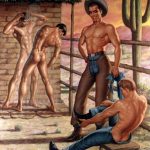To celebrate gay black history month 2025 The HaPenis Project would like to feature the work of African American photographer, Alvin Baltrop (1948-2004). Alvin photographed the gay community at the piers lining Manhattan’s west side in the 1970s. Pier 48 was then an abandoned wooden structure where gay men met to socialise and have sex. Alvin had relationships with men and women but never really put a label on his sexuality. Al Baltrop endured constant racism from gay curators, gallery owners and other members of the ‘gay community’ until his death. Many of these people doubted that Baltrop shot his own photographs; some implied or directly told him that he stole the work of a white photographer’. In 2008, four years after his death, Artforum critic Douglas Crimp wrote about Alvin’s work and brought it to a new audience. Alvin Baltrop’s photographs are celebrated for their historical significance and artistic merit, offering a poignant reflection on the complexities of urban life, sexuality, and identity in America. Source
Alvin Bastrop
More KnoBledge





























Celebrate gay black statue in my garden
Thank you Mr Cox and AJ I “grew up” as HIV was beginning- I was 15 yo. Learned to dance from Drag queens in the dance clubs. The drag queens wore bikinis on the beach. Some of them eventually transitioned. Many performed in clubs for a peanut wage, many did sex work. Never met one who wasn’t kind, generous and loving.
Men seemed so free in the Village and we marched annually in the Pride parade in manhattan. Later, “The Dance on the Pier” was always attended by us. So many smoking hot men were everywhere then whether it was Pride weekend or not.
Years later I was part of the largest group in the parade the last Sunday in June in NYC-the sober group. Looking north and south during the parade you could not see either end of the Sober group it was multiple blocks long of a mass of recovering individuals. Incredible.
Thank you again, Mr Cox for bringing these wonderful memories to me today. Thank you Aj and all our brothers. NYC is a special place for gatherings, festivals and street fairs. Magical even. And for anyone who loves fireworks put July 4 on one of the rivers (was always alternating from East river to Hudson river) put it on your fireworks bucket list. You will not regret it. Magical.
Peace, love and HaPenis.
There is a very good book called “The Mammoth book of Gorgeous Guys. All photos by leading photographers and mainly black and white photos. I am surprised Alvin Bastrop is not included in the book.. Cheers…Andrew
Hi Andrew, I don’t really know the answer to your question beyond what I have read in the really great short article by Alvin Crimp in Artforum; Seb provides the link above. One short answer I think is that Bastrop was interested in the life on the piers, where men got naked, sunbathed, and fucked, rather than in male bodies as such. Here is a great quote, cited in Crimp’s article, by Bastrop himself in his unpublished book on the piers:
“Although initially terrified of the piers, I began to take these photos as a voyeur [and] soon grew determined to preserve the frightening, mad, unbelievable, violent, and beautiful things that were going on at that time. To get certain shots, I hung from the ceilings of several warehouses utilizing a makeshift harness, watching and waiting for hours to record the lives that these people led (friends, acquaintances, and strangers), and the unfortunate ends that they sometimes met. The casual sex and nonchalant narcotizing, the creation of artwork and music, sunbathing, dancing, merrymaking, and the like habitually gave way to muggings, callous yet detached violence, rape, suicide, and, in some instances, murder. The rapid emergence and expansion of aids in the 1980s further reduced the number of people going to and living at the piers, and the sporadic joys that could be found there.”
I was on a pier at night near the Chinatown YMCA with my high school boyfriend in 1963. Bastrop’s description above and his photographs vividly recall to my mind what I remember of that night.
Like Fink’s photos, these black and white Bastrop photographs of naked men and derelict piers are thrilling to me. I’ve been there, at night, with a lover. You are naked, completely vulnerable, a wall, a roof, a cement wall could fall on you any minute, maybe someone is going to come out of the shadows and beat to death, but the feeling of vulnerability, the desolation, the rubble, the night just make you want to be naked forever, make you want to fuck and fuck and fuck, fuck, fuck your lover, any man, fuck the rubble, spray your cum everywhere and keep cumming and cumming and never put clothes back on and go back to the sexless world of daytime people when the dawn breaks and your lover will leave you forever.
Dear AJ!
Your comment is great! Real poetry,great literature taken from life! Thank you so very much!
You’re very welcome. Thank you for your kind comment.